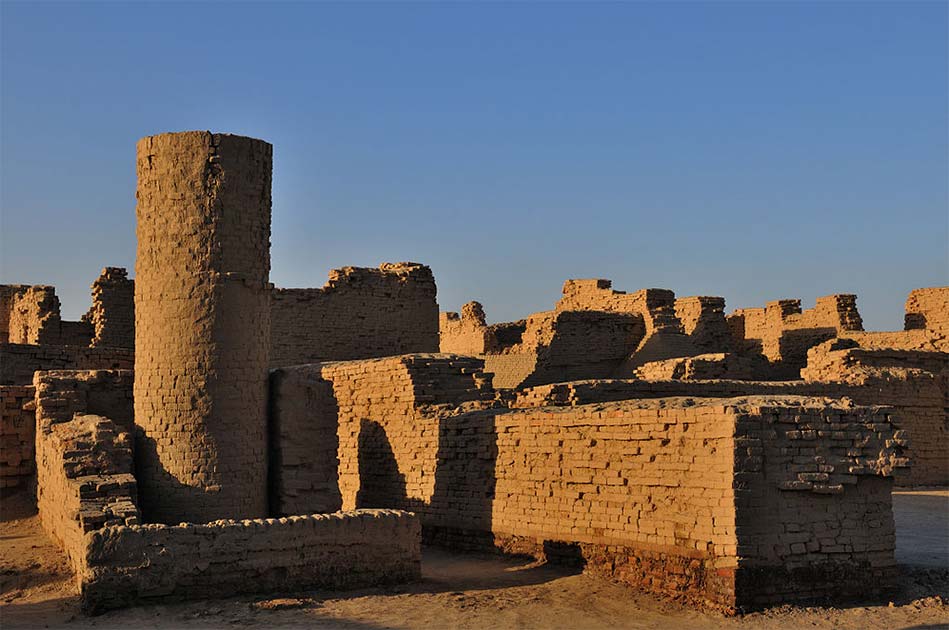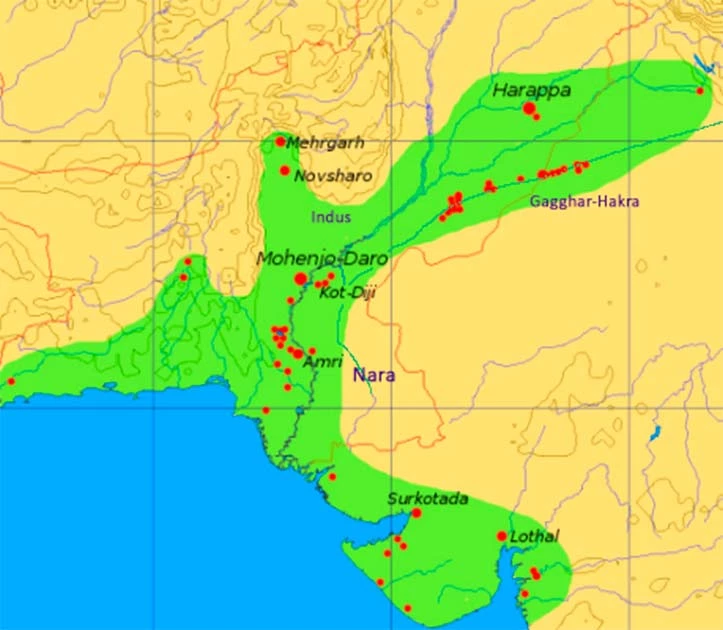The Harappans are probably the most interesting ancient culture you have never come across. This ancient bronze-age civilization located in the northwestern regions of South Asia from around 3,300 BC to 1,300 BC: these guys were amongst the first and longest-lived complex civilizations ever.
More often, they are referred to as the Indus Valley civilization which more properly refers to the period of their maturity around the years 2,600 BC to 1,900 BC. Along with Mesopotamia and Ancient Egypt, the Harappans were one of three early civilizations found in the Near East and South Asia.
Most impressive is the fact that they were the largest in this area spanning from Pakistan, up to Afghanistan and across to India. Primarily they flourished in the areas around the Indus River and the associated alluvial plain along Pakistan and other monsoon-created rivers.
The name Harappan is applied to this civilization because of the site found at Harappa in Pakistan. It was first excavated in the 20th century and was investigated alongside another site: Mohenjo-Daro.
What is most noticeable about this civilization is the fact that they had supreme urban planning alongside baked brick houses with elaborate drainage systems. Additionally, water supply systems have been found to have evidence of metallurgy and handicraft.
The size of these sites indicates that anywhere between 30,000 and 60,000 people may have lived there during the height of the civilization. However, it is believed that due to drought and drying of the area, they were slowly eliminated or fled to better areas.

But was this case? The fact that the Harappans disappeared in a similar timeframe to the other civilizations poses an intriguing thought. Was their interdependence on these western cultures what caused their decline?
The Indus Valley Civilization
The Indus civilization is named as such because of the Indus River system alongside which many of these structures were identified. Because the first site to be found was named Harappa, the Harappan name was given to the sites as a whole in the 1920s.
This is not their only name though. Ghaggar-Hakra is a more modern label applied to this civilization again due to the finds along the Ghaggar-Hakkar River. This culture existed in several different areas, with a notable outlier apparently clustered around lapis lazuli mines to the north.
- The Oxus Civilization and the Lost World of Central Asia
- (In Pics) Seven Civilizations lost in the Bronze Age Collapse
Unsurprisingly for such an enduring culture, the Harappan civilization was around at the same time as other famous civilizations in the Ancient World. Ancient Egypt, Mesopotamia, and China all had massive civilizations in this era.
By the time the Harappan people reached their maturity, they had spread across 1,500 kilometers (930 miles) up the alluvial plain of the Indus. This territory included a mix of disparate flora, habitats, and fauna, and was a paradise into which the Harappans could expand.
In the region of 6,500 BC, agriculture first emerged in this region. In the following 1,000 years, settled life became the norm on these plains which drove the growth of rural and urban settlements. With this style of living, naturally, the birth rate increased and urban centers began to spring up.
It has been estimated that in this period, the population of the area grew to around 4-6 million people. Unfortunately, this led to a rise in disease, and war as resources became scarce. Ultimately, however, the Harappans endured, and experts have estimated that the population of the Harappan civilization could have been as high as 5 million at its peak.
The area that this civilization covered as far as is known is from Balochistan in the west to Western Uttar Pradesh in the East, to Gujarat in the south, and to Northeastern Afghanistan.
Where Did They Go?
There is not a huge amount of evidence as to what ultimately ended the Harappan civilization. However, some strong theories have been developed from contemporary evidence.
Some have suggested that rivers became diverted in the late Harappan period which forced the civilization to migrate or die. This was combined with significant climate change which is also evidenced in the Middle East.

Since 2016, many scholars have hypothesized that a drought combined with a lack of trade and communication with neighboring civilizations in Egypt and Mesopotamia caused the collapse of the Harappan cities. Climate change was likely caused by a sudden and massive mega-drought and cooling period around 4,200 years ago.
The rivers that allowed the civilization to thrive such as the Ghaggar-Hakra was rain-fed and their ability to continue depended heavily on the monsoon season. As the Indus Valley climate grew cooler and drier in 1,800 BC, the monsoons became less and less frequent.
- (In Pics) Ten Great Lost Civilizations of Peru that aren’t the Inca
- Uruk, the First Great City: A Leap Forward for Humankind?
This happened around the world. The floods became more erratic and less extensive. The land became drier which reduced the water supply of the Harappans which ultimately led to their demise as they apparently fled eastwards to avoid the climate disaster.
Unlike their contemporaries, the Harappans were unable to master irrigation techniques and relied massively on seasonal monsoons. Their inability to adapt led them to their decline. It seems likely that the residents of cities such as Harappa moved eastwards and southwards where they established more nomadic residences that were more isolated and less connected. The cities were left to crumble and die.
What Remains
There have been many finds from the Indus Valley that give insight into how the Harappan society may have lived and how advanced they were. Pottery and terracotta have been excavated as have stone sculptures and gold jewellery.
Many of the figures that have been found are anatomically detailed and were made of bronze and terracotta. Games have been found to have six sided dice. The figures included cows, bears, monkeys, and dogs.
What was clear is that many of the crafts that existed in this period included shell working, bead making, and ceramic work. Many of these practices still happen in these areas today showing a small sense of continuity from the ancient world to the modern.

One of the most impressive aspects of the Harappan civilization is their work within metrology. The Harappans were able to measure time, mass, and length. It seems like they were among the first to develop a system of weights and measures.
A comparison of available objects suggests a large variation across the Indus territory. Their smallest measurement was marked by an ivory scale measuring only 1mm. It even seems likely that they followed a decimal division of measurement for practical purposes as can be seen through their shaped weights.
The cities of the Harappans also showed an extraordinary degree of uniformity, built to a common plan according to their measurement system. The streets would have been clean and spacious: the Harappans built effective sewage and drainage systems and large public baths while the rest of the world was learning how to grow crops and kill each other.
As is the case with many of these civilizations, who knows how advanced they could have become if they had not been dismantled by a stroke of bad luck?
Top Image: The Harappan city of Harappa. Source: Tejavalli reddy(1830787) / CC BY-SA 4.0.
By Kurt Readman